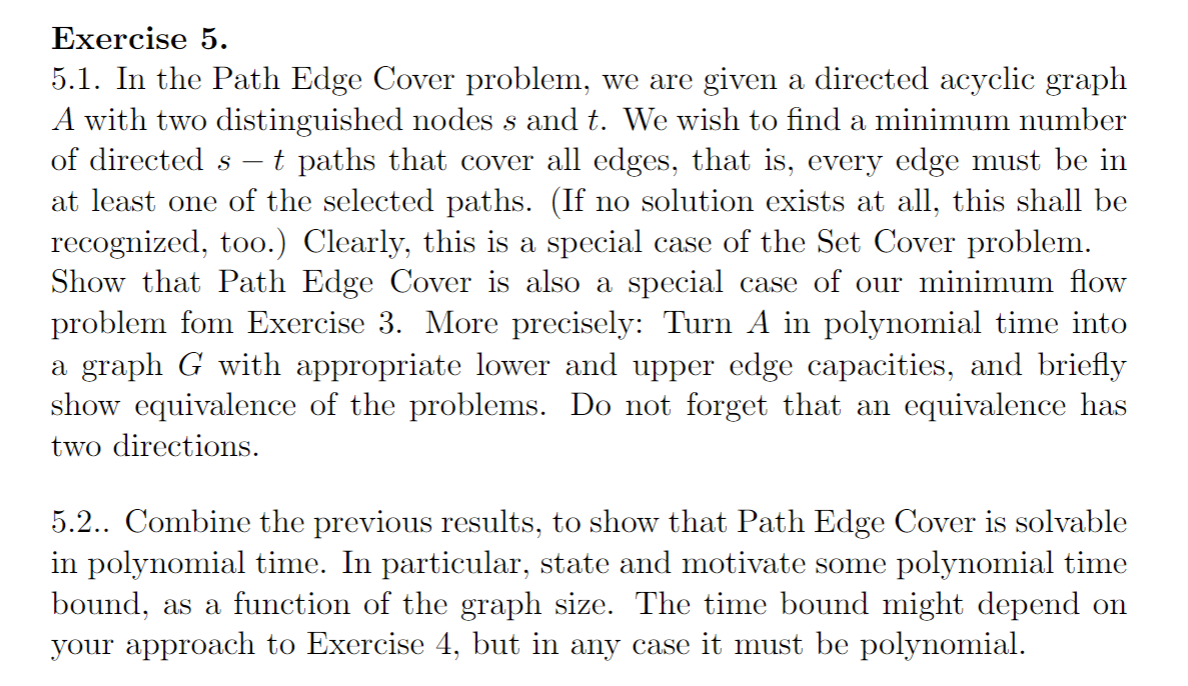5.1. In the Path Edge Cover problem, we are given a directed acyclic graph A with two distinguished nodes s and t. We wish to find a minimum number of directed s t paths that cover all edges, that is, every edge must be in at least one of the selected paths. (If no solution exists at all, this shall be recognized, too.) Clearly, this is a special case of the Set Cover problem. Show that Path Edge Cover is also a special case of our minimum flow problem fom Exercise 3. More precisely: Turn A in polynomial time into a graph G with appropriate lower and upper edge capacities, and briefly show equivalence of the problems. Do not forget that an equivalence has two directions.
5.1. In the Path Edge Cover problem, we are given a directed acyclic graph A with two distinguished nodes s and t. We wish to find a minimum number of directed s t paths that cover all edges, that is, every edge must be in at least one of the selected paths. (If no solution exists at all, this shall be recognized, too.) Clearly, this is a special case of the Set Cover problem. Show that Path Edge Cover is also a special case of our minimum flow problem fom Exercise 3. More precisely: Turn A in polynomial time into a graph G with appropriate lower and upper edge capacities, and briefly show equivalence of the problems. Do not forget that an equivalence has two directions.
Linear Algebra: A Modern Introduction
4th Edition
ISBN:9781285463247
Author:David Poole
Publisher:David Poole
Chapter3: Matrices
Section3.7: Applications
Problem 80EQ
Related questions
Question
Can u solve 5.1

Transcribed Image Text:Exercise 5.
5.1. In the Path Edge Cover problem, we are given a directed acyclic graph
A with two distinguished nodes s and t. We wish to find a minimum number
of directed s- - t paths that cover all edges, that is, every edge must be in
at least one of the selected paths. (If no solution exists at all, this shall be
recognized, too.) Clearly, this is a special case of the Set Cover problem.
Show that Path Edge Cover is also a special case of our minimum flow
problem fom Exercise 3. More precisely: Turn A in polynomial time into
a graph G with appropriate lower and upper edge capacities, and briefly
show equivalence of the problems. Do not forget that an equivalence has
two directions.
5.2.. Combine the previous results, to show that Path Edge Cover is solvable
in polynomial time. In particular, state and motivate some polynomial time
bound, as a function of the graph size. The time bound might depend on
your approach to Exercise 4, but in any case it must be polynomial.
Expert Solution
This question has been solved!
Explore an expertly crafted, step-by-step solution for a thorough understanding of key concepts.
Step by step
Solved in 5 steps with 2 images

Recommended textbooks for you

Linear Algebra: A Modern Introduction
Algebra
ISBN:
9781285463247
Author:
David Poole
Publisher:
Cengage Learning

Linear Algebra: A Modern Introduction
Algebra
ISBN:
9781285463247
Author:
David Poole
Publisher:
Cengage Learning